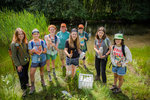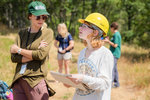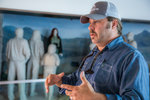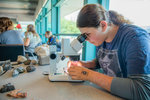
















Volcanoes don’t discriminate when they erupt, so why should any one group of people be over-represented in further understanding their effects?
Scientists with the U.S. Geological Survey (USGS) and Mount St. Helens Institute at Mount St. Helens want to spread the message that anyone, regardless of age, gender or anything else, can play a role in geology.
Thus, the GeoGirls were created.
One GeoGirls volunteer, Kaitlyn Trestrail, who works for GHD, an engineering consulting firm, was one of two girls in her department when she earned her degree in geology recently. Now, through the geology camp for middle and high school girls — which was back this week for the first time since the start of the pandemic — Trestrail can be a part of broadening the horizons and validating the dreams of the young girls, whether they want to be scientists or anything else.
“It takes a lot of grit and resiliency,” she said. “But being able to pass along the advice, passing along those experiences that we've learned from most to the younger generation, to these campers, it is invaluable.”
On Wednesday morning at the Mount St. Helens Science and Learning Center, girls from throughout Southwest Washington were wrapping up a week of geological projects. Three groups were deployed around the volcanic monument, with one studying sediment in Coldwater Lake and the North Fork Toutle River, another using seismometers to study the seismic signature of avalanches and lahars, while the third used microscopes to make observations about volcanic rocks.
In the sediment study, Renee Hoiland, 14, of Battle Ground, was one of the several girls using milk bottles to collect water samples from Coldwater Lake. She described how scientists had similar samples from 1949. By dipping the bottles in the water to slowly collect samples now, she said they were able to observe changes caused by the 1980 eruption.
“It is a lot of fun,” Renee said. “I thought it would be fun to meet people and I like camping.”
In the seismology study, girls were creating buckets of mud and collecting rocks before sending them down a hill near seismometers.
By pouring mud down the hill, they were simulating the seismic waves that would be seen during a lahar. With the large rocks, they simulated avalanches.
It is difficult to predict when these events will occur naturally. Through this project, geologists can train artificial intelligence to recognize the events and interpret lahars and avalanches in nature.
“And then that helps to, potentially if it’s a large one, to warn communities downstream. Because people live near river channels, or they recreate there,” said Liz Westby, a USGS geologist who helps organize the program, adding later, “To come here to Mount St. Helens and they actually get to use the equipment that we’re using, that scientists are using right now, they get to see how it works. It’s totally different than the classroom. In a way, I feel like it demystifies what a scientist is all about.”
Rainy Wu, 13, of Camas, completely agreed, saying she has never done anything similar to the camp’s hands-on learning in her middle school classes. According to her and new friend, Miranda Huibelt, 15, of Vancouver, the biggest takeaway from GeoGirls has been a newfound confidence and the ability to form connections with others who have shared interests.
“There was no awkward pause. Everybody just started talking and they just found things in common. And even though I'm older than most people here, it's like we're the same age. There's no difference between us. We're just out here enjoying nature and learning and just getting to experience all of this,” Miranda said.
Rainy added: “It gave me a bigger understanding of what each job is really about. I’m definitely more interested in geology after all this.”
In the group studying rocks, Paige Molyneux, 14, of Battle Ground, explained how she observed a split in one pumice stone with a microscope as she replicated the scene using watercolors.
As she described this, others at the table were painting landscapes and other scenes. Volunteers said this process is what science is all about: observing and documenting details of the world around us.
“We are all about advancing understanding and stewardship of the earth through science, education and exploration of volcanic landscapes,” said Ray Yurkewycz, executive director of the Mount St. Helens institute, adding later, “We look for ways that we can help facilitate a better connection and more equity in how people experience these things. … It is feeling like you can do science. You're actually doing science with scientists.”
For more on the institute, visit https://www.mshinstitute.org/. Learn about GeoGirls or sign up at https://www.mshinstitute.org/learn/for-parents/geogirls/geogirls.html.